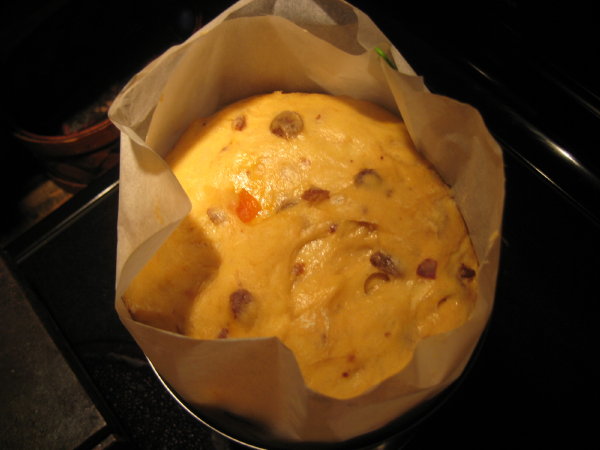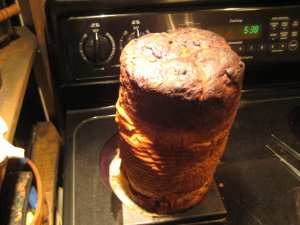It was with a good degree of trepidation that I approached the oven at the end of five hours, but I needn’t had, because the Panettone dough had nicely risen to within a few inches of the top of the mold, and it had a nice, shiny wet look. I removed it, covered, to a warm spot in the kitchen and proceeded to heat the oven to 370 for baking.

I let the oven heat beyond the 370 degree mark to assure that the entire oven was nice and hot. I cut an X in the top of the Panettone – not really easy with a wet dough – but it went OK and I didn’t notice any deflation as a result. The recipe calls for a cold Tbs of butter being placed in the center of the X, I suppose to lubricate the new cut surface and keep it from “crusting” during the oven-spring stage – a soft top during that time will assure that the Panettone will continue to rise for the first 15 minutes of baking. I tested at the suggested end-time, but it needed another 15 minutes before the skewer came out clean.
The Panettone came out of the can easily enough, but here began the most critical part of the baking – because the Panettone had risen so much – Yes, it’s supposed to – and because it’s a wet dough, upon exiting the oven, it is relatively soft. If you simply put it on its bottom to cool, it would depress upon itself. So the recipe suggests that you use two skewers placed at 4 inch intervals around the bottom of the Panettone, 1 inch from the bottom itself. And then you turn the Panettone over the inside a large stock pot, and let it cool. I thought I could get away with 2 skewers (which would give you 4 support spots), but I actually needed 4 skewers to keep it from tearing, which of course it did! That’s why in my pic, the Panettone looks like it’s listing a bit. So, use 4 skewers right from the start, and make sure you have them level on all sides. It’ll take about 1 hour to completely cool and firm up.

Was it worth the time and agony (well, not much agony, actually)? Yes, but with a few qualifiers. First, I don’t really understand the shape thing! Why must Panettone be so tall? It makes it not only difficult to cool, but difficult to cut and serve. If tradition is the reason, then next time I do Panettone I’ll choose to try baking in loft pans or even a cake pan – and we’ll see the difference. And of course, I’ll be sure to make my dough nice and wet – that’s really the secret to making the long slow rise work in your favor, and to avoiding the usual kneading process. It really is quite delicious, and a wonderful addition to the holiday menu.
Since Lahey’s recipe is not yet online, here it is, with all appropriate thanks to Gourmet magazine and to Jim Lahey.
Jim Lahey’s, “Easy” Panettone
Ingredients:
1 cup raisins
2 Tbs light rum
2/3 cup tepid water plus 2 Tbs hot water, divided
3 ¾ cups all purpose flour
2/3 cup sugar
½ tsp salt
½ tsp instant dry yeast
¼ tsp grated lemon zest
½ vanilla bean, split lengthwise (I used 1 tsp vanilla extract)
3 large eggs, at room temperature
1 Tbs honey
12 ½ Tbs unsalted butter (10 ½ Tbs cut into Tbs size pieces and well softened; 1 Tbs melted; and 1 Tbs chilled)
2/3 cup candied fruits, chopped into small pieces if large.
Procedure:
-
Soak raisins in rum and 2 Tbs hot water (8 hours or overnight)
-
Mix flour, sugar, salt, yeast, lemon zest, and vanilla bean in stand mixer bowl with paddle until well mixed. In another bowl, whisk together the eggs, the honey, and the 2/3 cup of tepid water. With mixer at low speed, slowly pour the egg mixture into the flour mixture – up speed to medium low, and continue mixing until well combined. Add 10 ½ Tbs softened butter, 1 Tbs at a time, mixing until well incorporated between additions (Frozen/cold butter softens nicely in the microwave, but since each is sooo different, you’ll have to experiment to find the perfect time for yours – mine would be soft in about 15-25 seconds for this chunk.). Increase mixer speed to med high and mix until dough is smooth and elastic – about 8 minutes.
-
Drain raisins and mix with chopped fruit and 1 Tbs melted butter – stir into the dough mixture with a wooden spoon.
-
Put mixture into a large bowl, cover with plastic wrap, and put into a cold oven for 12-15 hours.
-
Lightly flour a board, and put the dough on the board – remove the vanilla bean, and sprinkle a light dusting of flour over the dough – pull the edges of the dough up onto itself, and turn it over into a ball.
-
Prepare your Panettone mold with either a paper liner or a piece of baker’s parchment held with a paper clip – move the dough into the mold, cover with a damp kitchen towel (not terry), and put in a warm spot where it can rise for 3-5 hours.
-
With an hour left in the dough rising time, turn your oven on to 370 degrees, and heat.
-
Cut an X in the top of the risen Panettone, and place the remaining Tbs of cold butter in the middle of the X – Put the Panettone mold/can on a baking sheet/pan and bake for an hour to an hour and a quarter – I needed 1 and ½ hours – test doneness with a skewer; it should be moist but clean – if you see dough, give it another 5-10 minutes.
-
When done, remove from oven, and remove from mold/can – measure 1 inch from the bottom of the Panettone and slide 4 skewers through the bottom from one side to the other – now suspend the Panettone upside down into a large stock pot (or two chairs), and let it cool completely, about 1 hour.

Panettone – a worthy addition to the special treats of Butter Season – and a holiday tradition that deserves, at least, to be on every baker’s resume. Try it – it may become your tradition too.


I make mine in 23 oz. cans, usually from whole tomatoes, with which I make sauce, naturally. That size is much more manageable.
I don’t recall any instructions on skewering or hanging the panettone for cooling. maybe the smaller size I prefer negates that.
Well, that’s sure an idea for next time – I’m wondering if the fact that Lahey developed a wetter dough for his recipe, required the skewering process – ??? Whatever, we adjust and try again – right Diane?
Thanks for visiting and for your comment.
doc
Here is another person’s blog featuring the same recipe. She explains that the reason the bread is held upside down is to prevent it from falling as it cools. Thank You for the recipe, description and pictures. I’m starting it tonight for a holiday party hosted by some Italian friends tomorrow.
http://www.andreasrecipes.com/2008/12/25/slow-rise-panettone/
this is a solo baking with variation on a panettone and I love it. It seem like we a share quit a bit of attitude; little respect for authorities and their scripts. Before i reached the end of your column I though do we have to defy gravity?Surprise, at the end telling us we do not have to challenge nature,
Eliana/abdo,
Thanks for visiting and commenting – if you make a panettone this season, I hope it looks better than this one! Actually, my latest panettone effort was better than this one. https://drfugawe.wordpress.com/2009/12/20/sneaking-up-on-christmas/
Enjoy the holidays.
Thank you so much for sharing this. I sure have the
3 pounds coffe cans. I will try it out.
I know that there are paper molds for panettone but they
are really expensive. So for the first try I will go for the homemade version of molds.
Many thanks again.
Yeah, I think there’s lots about panettone that’s more expensive than it should be – no reason why perfectly beautiful panettone can’t be done without the expense and fru-fru.
Best wishes for success!
Pingback: Panettone – a Christmas Challenge « The Lost World of Drfugawe